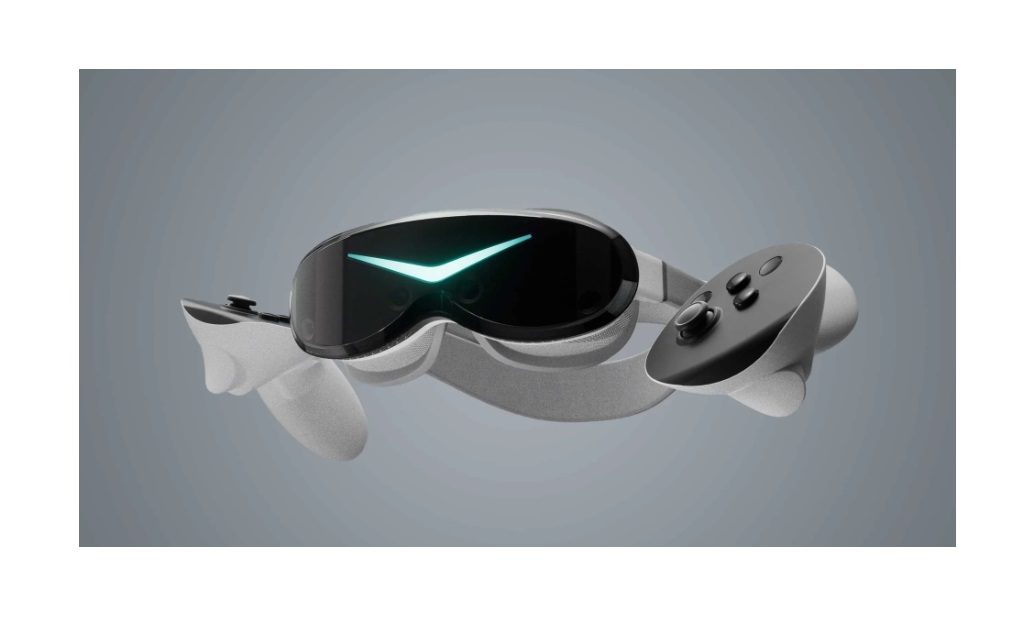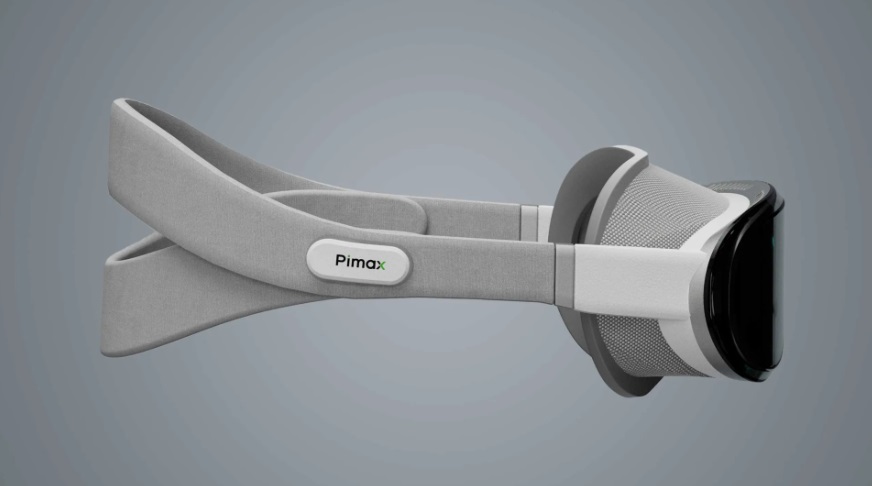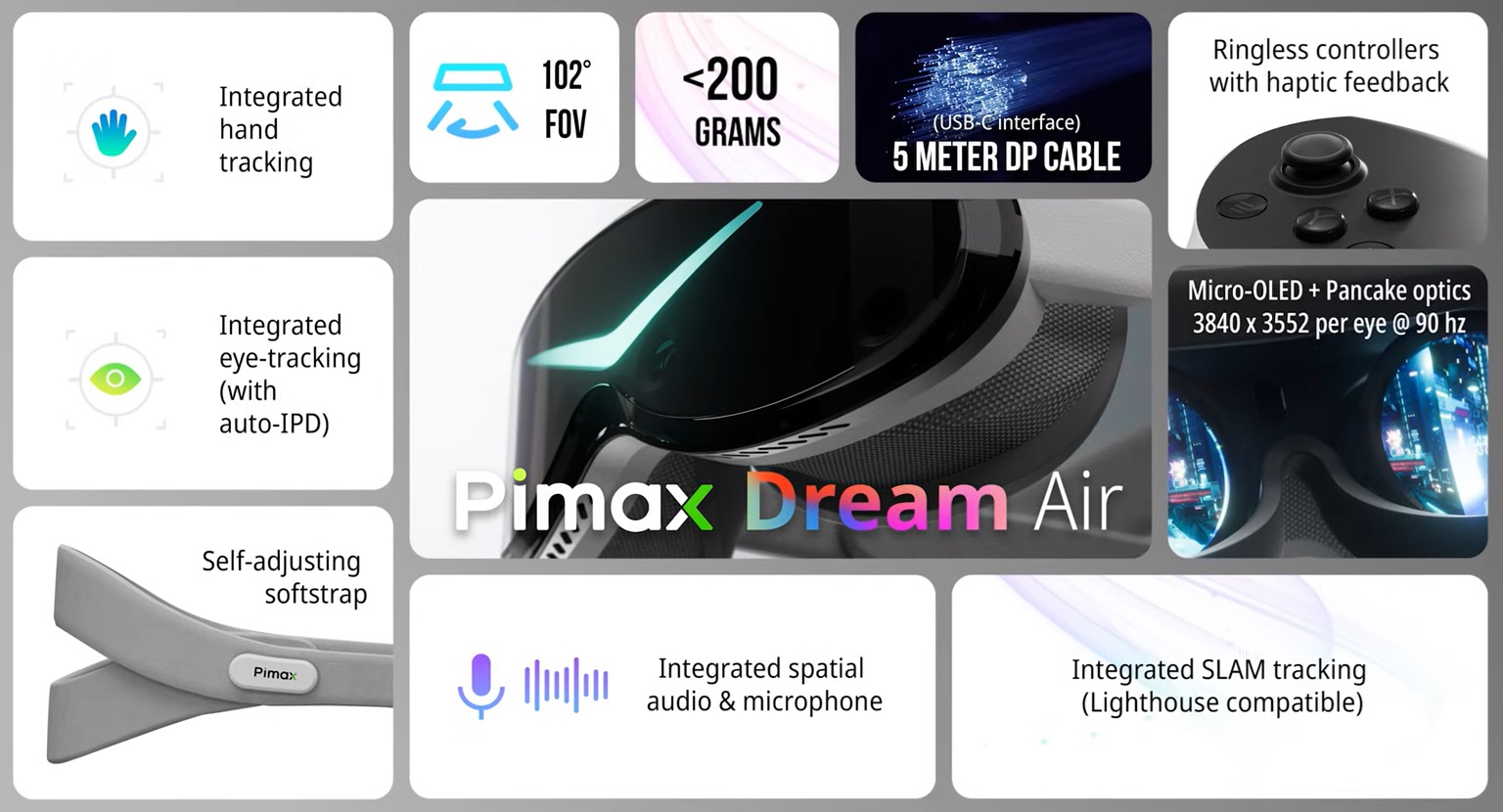Pimax just announced its new flagship PCVR, Dream Air, which comes with a never-before-seen feature while borrowing most of the standard features on the previously announced Crystal Super, which was to launch in Q4 2024 but postponed to Q1 2025.

The Pimax Dream Air is still an upcoming VR headset, as it has not been launched yet, too. However, Pimax released an official announcement highlighting the specifications and techs integrated into the device, and it’s a PCVR. Dream Air comes as a small and lightweight headset, featuring a self-adjusting backstrap and up to 27 million pixels for the 8k resolution. Here’s everything to know about this headset.
Pimax Dream Air Overview
The pretty lightweight headset features head, hand, and eye tracking, along with support for spatial audio and a self-adjusting back strap. It is said to weigh less than a half-filled Coca-Cola bottle and still manage to be a full-feature VR headset—really atypical of Pimax VR headsets, which are necessarily bulky to accommodate their standard features, such as large FOVs.

One may wonder, how did all its features get it without adding more weight? Well, Pimax may have just hacked a tweak that other VR headset manufacturers will adopt soon. The Dream Air PCVR borrows a good number of features from the Pimax Crystal Super; this includes the micro-OLED panels and pancake lenses.
8K resolution with a 90 Hz refresh rate might not be the best combination to expect, but that’s what was announced. Alongside, the display is mentioned to support a wide field of view with a large sweet spot. All these are not unusual to what we’ve read about Pimax’s headsets—all the time. It might also sound interesting that Dream Air will likely integrate a Snapdragon XR2 chip and offer an optional SteamVR Tracking faceplate.
The Pimax Dream Air is currently priced at $1,900 and reported to ship in May 2025. This headset appears to be Pixmax’s entry into the emerging segment of compact high-end PC VR headsets, joining the likes of Shiftall MaganeX Superlight and Bigscreen Beyond.
Features and Specifications
- Dual micro-OLED panels, 3840 x 3552 resolution each
- Pancake lenses, 8k @90Hz
- HDR support with individual pixel control
- Up to 4 integrated cameras for 6DoF inside-out tracking
- Wide field of view with a large sweet spot
- Eye tracking with dynamic foveated rendering and auto-IPD adjustment
- Hand tracking with gesture control
- Built-in mic, spatial audio
- Self-adjusting backstrap
- Ringless controllers with haptic feedback
- DisplayPort connection via USB-C
- USB-C port for additional accessories
- Optional “Cobb” – Snapdragon XR2-powered puck for PC-free usage

Announced Pimax Dream Air Features Explained
The Dream Air is really going to be the world’s smallest, lightest, full-feature 8K VR headset if it launches with all the specs and features that Pimax has announced.
Automatic Strap Tightening
This unique feature on the Dream Air draws a lot of attention; it is a feature that allows the backstrap to adjust automatically. Apparently, this authentic backstrap technology has not been used in any major headset to date—this is going to be a “real deal” for most people since it promotes comfort.
A closer look at the renders shown for this strap, it appears that Pimax hid a tightening mechanism under the strap’s fabric, so when you wear the headset, the strap kind of shrinks into place without you having to do anything. Quite a good tech, but until the device launches with it, we can only “hope” this feature works as smoothly as shown in renders.
Good Display and Tracking
Four integrated cameras with six degrees of freedom (6DoF) will guarantee seamless head movement tracking. The headset is also said to support inside-out tracking powered by Pimax’s proprietary SLAM algorithm, so you can launch the device without base stations.
Still on the tracking, Dream Air is shown to support integrated eye tracking & auto-IPD. Now, this is another boomer—automatic IPD. The headset uses custom pancake lenses with a 102° FoV; the auto-IPD will help adjust the lenses-to-user’s-eyes distance for a better view.
It is worth noting that the headset goes on to feature a 13MP camera sensor (3,840 × 3,552 pixels) on both micro-OLED displays, shooting at a 90Hz refresh rate and with HDR support. Hand tracking is also supported with the ringless motion controllers. Aside from gaming, Pimax’s Dream Air appears ready for other VR applications.
Speakers and Audio
The trend continues, “Spatial Audio.” That’s what you will get on the Dream Air PCVR. With integrated spatial speakers, the Dream Air headset is certain to deliver high-quality audio. While the number is not disclosed, the headset is announced to feature integrated microphones for audio/voice input.
Connections and Accessories
Pimax’s Dream Air headset is a PC VR that can run on its own even without base stations, thanks to the puck Cobb. Pimax is also adding a type-C DisplayPort cable in the pack for uncompressed visuals. The headset is also mentioned to be compatible with modular accessories like prescription lenses and Lighthouse faceplates.
According to Pimax, the previously announced Crystal Super headset that is yet to launch focuses on improving VR flight/racing simulation experiences, whereas the upcoming Dream Air is being made for “active VR users,” hence the ultra-lightweight design. Dream Air is tailored for room-scale VR, VRChat, and entertainment on the go.
More Than a PC VR?
Pimax mentioned a Cobb in development, which would come along with a Qualcomm Snapdragon XR2 chip and a battery, so the headset can still run as a standalone unit. This optional compute puck doesn’t have much information shared about it, aside from the Snapdragon chip. As a standalone headset—via the Cobb—Dream Air could run light applications, stream movies, and run games via Steam VR. Adding the optional SteamVR Tracking faceplate too, the Dream Air could be a really versatile 8k VR headset that changes the narrative.
Pricing, Availability, and Shipping
The Pimax Dream Air starts at USD 1,895, and this base price includes a pair of ringless controllers. However, early shoppers can take advantage of the special pre-order price of USD $1,199, and there’s still an option for part payment: USD $696 (12% discount) one-time payment or USD $32.99 monthly for 24 months (but you must have a Pimax Prime membership). Shipping is officially announced to begin in May 2025, according to Pimax.
Conclusion
While it appears Pimax is testing a new segment of compact, lightweight VR headsets, the company isn’t giving up on its notable boxy, larger, and wider FoV headsets. The Dream Air is just like a bespoke invention to try out something different from the usual. We hope it works out.
